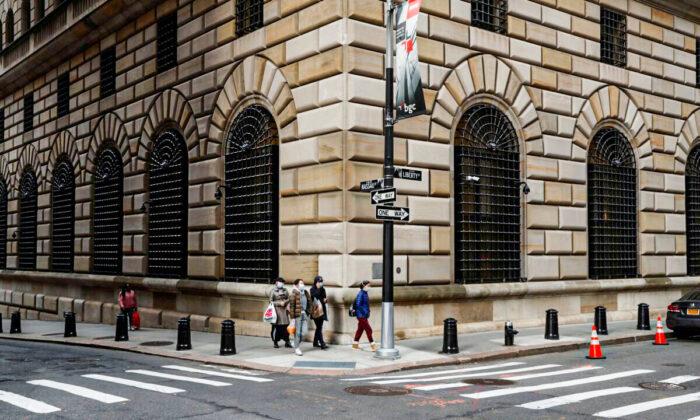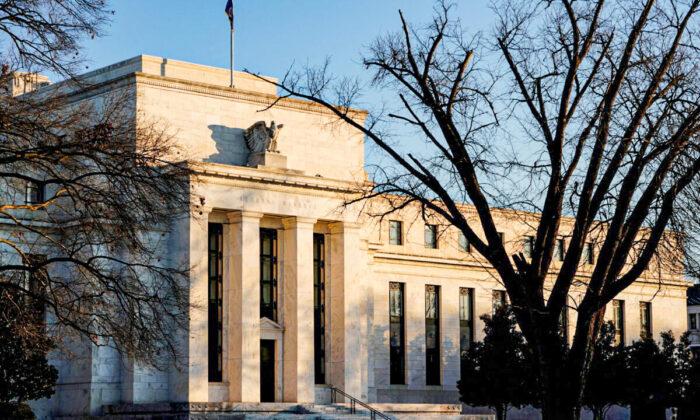Despite mountains of evidence and ample warning, investors are mispositioned ahead of the Federal Reserve’s accelerated tapering plans. On Jan. 13, the New York Fed announced its new purchase schedule, which began on Jan. 14, that will reduce its total purchases of U.S. Treasury and mortgage-backed securities to $60 billion per month—half of the amount the Fed was purchasing each month before announcing a balance sheet taper.
Investors who previously believed quantitative easing would lead to higher interest rates, and either sold or shorted the Treasury bond market to profit on the move, are now doubling down their bets on higher interest rates. Investors are almost certain that without the support of the Federal Reserve, nobody will want to purchase U.S. government debt.
Yet, the large commercial banks must buy bonds with customer deposits, as there’s an insufficient amount of loans to back all the deposits in the banking system. In addition, foreign central banks continue to buy U.S. government debt each month as a byproduct of trade with the United States.
When dollars flow out of the United States through trade, those dollars are recycled back to the United States when foreign central banks purchase U.S. government debt. As long as the United States is running a trade deficit, dollars must be recycled back into U.S. government debt. Both the commercial banks and foreign central banks provide a large and ongoing demand for U.S. government debt.
While there’s some debate about how effective quantitative easing is at suppressing or lowering interest rates, the certainty among investors that rates must rise has put upward pressure on Treasury yields. However, history remains in opposition of higher Treasury yields, as yields have fallen every time the Fed has ended or tapered its balance sheet.
Following the end of quantitative easing 1, 10-year Treasury yields fell more than 1.25 percent. Ten-year Treasury yields fell nearly 1.25 percent following quantitative easing 2, and after quantitative easing 3 ended, they fell more than 1.25 percent. A similar move today would put 10-year Treasury yields near 0.5 percent.
History is in direct contradiction with investor expectations today. It’s possible those post-quantitative easing declines in yields were anomalies and that this time will be different. Investors who are betting against the bond market will be substantially rewarded for their brazen bets should yields rise. Yet, investors repeatedly fail to seek the truth as to why long-term Treasury yields not only fall at the end of quantitative easing but also set new all-time lows early in monetary tightening cycles.
Short-term Treasury yields tend to anticipate the direction of the federal funds rate and lead it both higher and lower. Two-year Treasury yields are an excellent proxy for the direction of the federal funds rate, as it does an excellent job of leading every decision by the Federal Open Market Committee.
On the other hand, long-term Treasury yields aren’t correlated with the federal funds rate. Long-term Treasury yields are influenced by monetary policy to the extent that they price in future growth and inflation expectations.
When long-term Treasury yields are rising, they’re validating future growth, and inflation expectations are likely to increase. That’s why rising stock prices, a poor proxy for future growth and inflation expectations, need Treasury yields to rise alongside them as a form of validation. When long-term Treasury yields are falling, they’re indicating weaker growth, and lower inflation expectations as an indication that monetary policy is too tight.
When the Fed begins to remove policy accommodations through a balance sheet taper or outright end of a large-scale asset purchase program, future growth and inflation expectations tend to fall. The same holds true at the onset of early increases to the federal funds rate, as the bond market remains skeptical of the economy’s ability to expand without the support of the Fed.
Investors have foolishly bought into the belief the Fed is removing its monetary crutches on the economy due to future growth expectations. Instead, the Fed is focusing on price stability, a mandate set by Congress that the Fed has never been able to achieve. While the Fed may or may not believe the economy can handle the removal of policy accommodation is irrelevant.
Following quantitative easings 1, 2, and 3, the bond market realized the Fed was likely making a huge policy mistake. Financial conditions tightened each time, which sent long-term Treasury yields to new all-time lows. The bond market validated that, without the support of the Fed, the economy was at risk of slipping into another recession.
While investors are hoping to cash in big on their bets of higher Treasury yields, history has shown that the economy is more likely to contract without the support of the Fed. Once again, investors will find themselves mispositioned as an accelerated balance sheet taper and the end of monetary policy support will lead to lower, not higher, Treasury yields.





